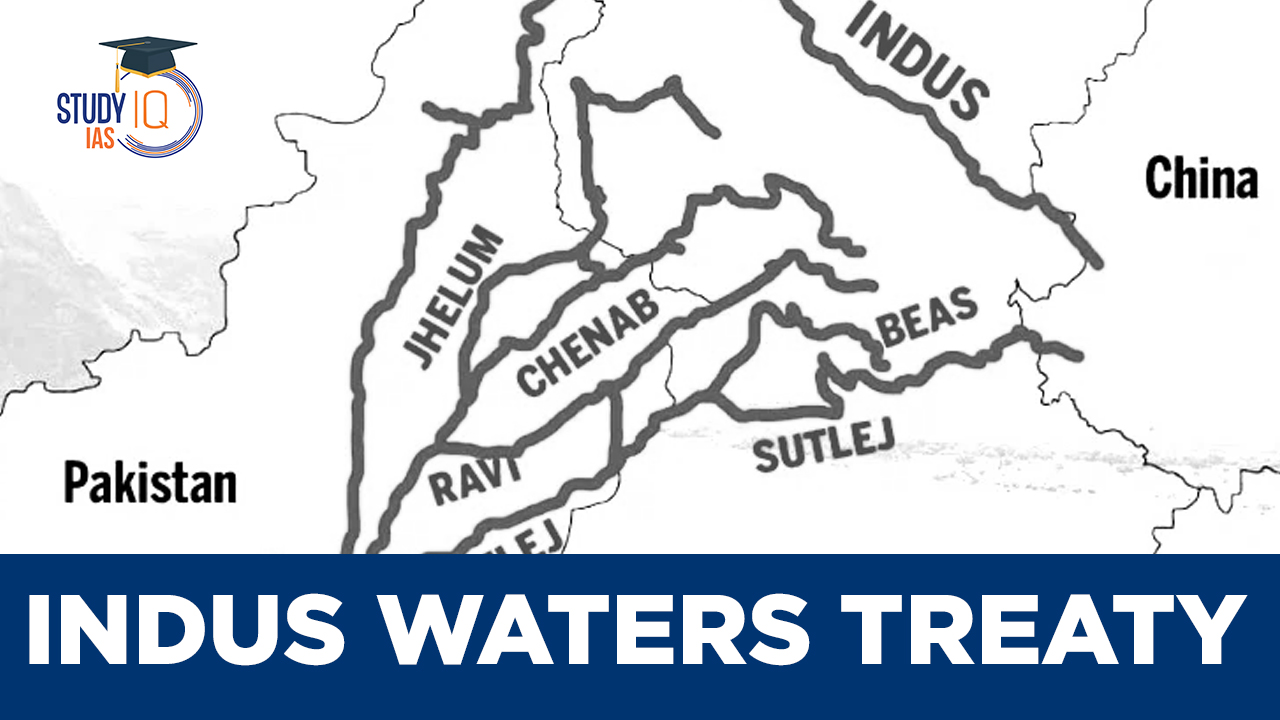Table of Contents
Context: The Union government instructed officials in Jammu & Kashmir to scale up efforts for “better utilisation of the country’s rights under the Indus Waters Treaty (IWT)” over the three rivers flowing through the Union Territory.
Understanding Indus Water Treaty
Indus Water Treaty:
- The Indus Waters Treaty (IWT) is a water-distribution treaty between India and Pakistan to use the water available in the Indus River and its tributaries. It was mediated by World Bank.
- It was signed in Karachi in 1960 by then Indian Prime Minister Jawaharlal Nehru and Pakistani president Ayub Khan.
- Under the treaty, the control over the waters of the three eastern rivers (Beas, Ravi and Sutlej) is given to India.
- The control over the waters of the three western rivers (Indus, Chenab and Jhelum) is given to Pakistan.
The treaty allows India to use western river waters for limited irrigation use and unlimited non-consumptive use such as power generation, navigation, floating of property, fish culture, etc.
Disputes in Indus Waters Treaty
- Pakistan has repeatedly raised objections against two hydroelectric power projects that India is constructing – one on the Kishanganga river, a tributary of Jhelum, and the other on the Chenab.
- Pakistan has asked that a Neutral Expert should be appointed to examine its technical objections to the Kishanganga and Ratle HEPs. It later proposed a Court of Arbitration.
- India requested for appointment of a Neutral Expert, arguing that Pakistan’s request for a Court of Arbitration violated the graded mechanism of dispute resolution in the Treaty.
- After the 2016 Uri Attacks, there were talks within India to walk out of the Indus Waters Treaty, which allots a significantly bigger share of the six river waters to Pakistan.
How are Disputes addressed under the treaty?
- Dispute redressal is provided under Article IX of the IWT. It’s a 3-level mechanism that makes it obligatory for India to inform Pakistan that it is planning to build a project on the Indus River system.
- Pakistan might oppose it and ask for more details. In case there is a question, that question must be clarified between the two sides at the level of the Indus Commissioners.
- If it is not clarified, it becomes a difference that has to be handled by a Neutral Expert. It is at this stage that the World Bank enters the picture.
- In case Neutral Expert is unable to resolve the difference, then it becomes a dispute. The dispute then enters the Court of Arbitration.

Reasons for India’s notice to Amend the Treaty
India in the recent past issued a notice to Pakistan seeking modification of the decades-old Indus Waters Treaty (IWT).
- The government invoked Article XII (3) of the treaty that allows modification of the provisions by a duly ratified treaty concluded for that purpose between the two Governments.
- However, it is not obligatory for Pakistan to allow for modifications.
- Strategic tool: There has been a growing demand in India to use the Indus Waters Treaty as a strategic tool, considering that India has a natural advantage being the upper riparian state.
- Full utilization of rights: India has not fully utilized its rights over the waters of the three eastern rivers (Ravi, Beas and Sutlej) over which India has full control under the Treaty.
- It has also not adequately utilized the limited rights over the three western rivers (Indus, Chenab and Jhelum).
- India had established a high-level task force to exploit the full potential of the Indus Waters Treaty. The new notice is part of the efforts.
- Hydropower projects: By modifying the treaty, India aims to start several big and small hydroelectric projects that had either been stalled or were in the planning stages.
The Kishanganga Hydroelectric Power Project
- About: It is a run-of-the-river hydroelectric power project by the Government of India on the Neelum River (or Kishanganga), a tributary of the Jhelum River.
- Location: It is located near Bandipore in the Kashmir valley.
- Project details:
- The project includes a concrete-face rock-fill dam designed to divert water from the Kishanganga River through a tunnel to a power plant in the Jhelum River basin.
- Timeline:
- Construction on the project began in 2007 and was expected to be complete in 2016.
- It was halted in 2011 due to a concern of Pakistan that the project will impact the flow of the Kishanganga River to downstream areas in Pakistan-administered Kashmir.
The Ratle Hydroelectric Power Project
- About: It is a run-of-the-river hydroelectric power project by the Government of India on the Chenab River.
- Location: It is located near the Drabshalla Village in Kishtwar district of the Jammu and Kashmir.
- Project details: It includes a 133 m tall gravity dam and two power stations adjacent to one another.
- Timeline:
- In June 2013, the then Indian Prime Minister laid the foundation stone for the dam.
- The Pakistan government in 2013 had objected to the construction of the dam, claiming that it was not in conformity with the Indus Water Treaty.
- In August 2017, the World Bank allowed India to construct the dam.
Pakistan has approached the World Bank with fresh protests, but the Centre has now decided to go ahead with the construction.


 SSC CGL Exam 2025 Apply Online Starts Ap...
SSC CGL Exam 2025 Apply Online Starts Ap...
 Daily Quiz 19 April 2025
Daily Quiz 19 April 2025
 Vehicle-to-Grid (V2G) Technology and its...
Vehicle-to-Grid (V2G) Technology and its...





















